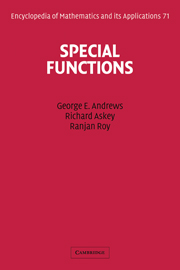Book contents
- Frontmatter
- Contents
- Preface
- 1 The Gamma and Beta Functions
- 2 The Hypergeometric Functions
- 3 Hypergeometric Transformations and Identities
- 4 Bessel Functions and Confluent Hypergeometric Functions
- 5 Orthogonal Polynomials
- 6 Special Orthogonal Polynomials
- 7 Topics in Orthogonal Polynomials
- 8 The Selberg Integral and Its Applications
- 9 Spherical Harmonics
- 10 Introduction to q-Series
- 11 Partitions
- 12 Bailey Chains
- A Infinite Products
- B Summability and Fractional Integration
- C Asymptotic Expansions
- D Euler–Maclaurin Summation Formula
- E Lagrange Inversion Formula
- F Series Solutions of Differential Equations
- Bibliography
- Index
- Subject Index
- Symbol Index
5 - Orthogonal Polynomials
Published online by Cambridge University Press: 05 May 2013
- Frontmatter
- Contents
- Preface
- 1 The Gamma and Beta Functions
- 2 The Hypergeometric Functions
- 3 Hypergeometric Transformations and Identities
- 4 Bessel Functions and Confluent Hypergeometric Functions
- 5 Orthogonal Polynomials
- 6 Special Orthogonal Polynomials
- 7 Topics in Orthogonal Polynomials
- 8 The Selberg Integral and Its Applications
- 9 Spherical Harmonics
- 10 Introduction to q-Series
- 11 Partitions
- 12 Bailey Chains
- A Infinite Products
- B Summability and Fractional Integration
- C Asymptotic Expansions
- D Euler–Maclaurin Summation Formula
- E Lagrange Inversion Formula
- F Series Solutions of Differential Equations
- Bibliography
- Index
- Subject Index
- Symbol Index
Summary
Although Murphy [1835] first defined orthogonal functions (which he called reciprocal functions), Chebyshev must be given credit for recognizing their importance. His work, done from 1855 on, was motivated by the analogy with Fourier series and by the theory of continued fractions and approximation theory. We start this chapter with a discussion of the Chebyshev polynomials of the first and second kinds. Some of their elementary properties suggest areas of study in the general situation. The rest of this chapter is devoted to the study of the properties of general orthogonal polynomials.
Orthogonal polynomials satisfy three-term recurrence relations; this illustrates their connection with continued fractions. We present some consequences of the three-term relations, such as the Christoffel–Darboux formula and its implications for the zeros of orthogonal polynomials. We also give Stieltjes's integral representation for continued fractions which arise from orthogonal polynomials.
In his theory on approximate quadrature, Gauss used polynomials that arise from the successive convergents of the continued fraction expansion of log(1 + x)/(1 − x). Later, Jacobi [1826] observed that these polynomials are Legendre polynomials and that their orthogonality played a fundamental role. We devote a section of this chapter to the Gauss quadrature formula and some of its consequences, especially for zeros of orthogonal polynomials. We also prove the Markov–Stieltjes inequalities for the constants that appear in Gauss's formula.
Information
- Type
- Chapter
- Information
- Special Functions , pp. 240 - 276Publisher: Cambridge University PressPrint publication year: 1999
